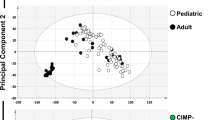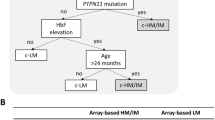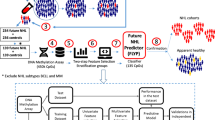Abstract
Deregulated methylation of cytosine in DNA is a frequent finding in malignancy that is reflected by general genomic hypomethylation and regional hypermethylation that includes the myogenic gene Myf-3. In this study of 198 DNA samples from 186 patients with a wide range of lymphoproliferative disorders (LPD), the methylation status of Myf-3 was assessed to evaluate its significance in the diagnosis of malignant LPD. DNA was digested with the restriction endonucleases HpaII and MspI, and using the Southern blot (SB) technique, the size and density of fragments that hybridized with a Myf-3 probe were used to assign the methylation status. None of the samples from 45 patients from a wide age range with benign LPDs had evidence of altered Myf-3 methylation and there was no age-related methylation change. By contrast, 115/123 (93%) of samples from patients with non-Hodgkin lymphoma (NHL) or lymphoid leukemia had increased Myf-3methylation. There was no methylation alteration in 22/24 (92%) of samples from patients with Hodgkin lymphoma (HL), nor in five of six samples from LPDs that had atypical histopathologic features which were not diagnostic of lymphoma, while the remaining sample of atypical LPD had hypermethylated Myf-3 fragments. There was an association between increasing Myf-3 methylation and higher histopathologic grade of malignancy within specific lymphoma categories. It is concluded that the detection of increased Myf-3 methylation is a sensitive and specific test of malignancy which may complement other molecular methods that are currently used for the assessment of clonality. It may be of particular diagnostic use in natural killer (NK) and null cell malignancies for which other indicators of clonality are lacking. Furthermore, methylation status may prove to be of potential prognostic value.
This is a preview of subscription content, access via your institution
Access options
Subscribe to this journal
Receive 12 print issues and online access
$259.00 per year
only $21.58 per issue
Buy this article
- Purchase on Springer Link
- Instant access to full article PDF
Prices may be subject to local taxes which are calculated during checkout






Similar content being viewed by others
References
McCarthy KP, Sloane JP, Kabarowski JHS, Matutes E, Wiedeman LM . A simplified method of detection of clonal rearrangements of the T-cell receptor-γ chain gene Diagn Mol Pathol 1992 1: 173–179
Trainor KJ, Brisco MJ, Story CJ, Morley A . Monoclonality in B-lymphoproliferative disorders detected at the DNA level Blood 1990 75: 2220–2222
Spagnolo DV, Taylor J, Carrello S, Saueracker E, Kay PH . Southern blot analysis of lymphoproliferative disorders: use and limitations in routine surgical pathology Pathology 1994 26: 268–275
Holliday R . The inheritance of epigenetic defects Science 1987 238: 163–169
el-Deiry WS, Nelkin BD, Celano P, Yen RW, Falco JP, Hamilton SR, Baylin SB . High expression of the methyltransferase gene characterizes human neoplastic cells and progression stages of colon cancer Proc Natl Acad Sci USA 1991 88: 3470–3474
Robertson KD, Uzvolgyi E, Liang G, Talmadge C, Sumegi J, Gonzales FA, Jones PA . The human DNA methyltransferases (DNMTs) 1, 3a and 3b: coordinate mRNA expression in normal tissues and overexpression in tumours Nucleic Acids Res 1999 27: 2291–2298
de Bustros A, Nelkin BD, Silverman A, Ehlich G, Poiesz B, Baylin SB . The short arm of chromosome 11 is a ‘hot-spot’ for hypermethylation in human neoplasia Proc Natl Acad Sci USA 1988 85: 5693–5697
Chen B, Dias P, Jenkins JJ, Savell VH, Parham DM . Methylation alterations of the MyoD1 upstream region are predictive of subclassification of human rhabdomyosarcomas Am J Pathol 1998 152: 1071–1079
Braun T, Bober E, Buschhausen-Denker G, Kotz S, Grzeschik K-H, Arnold HH . Differential expression of myogenic determination genes in muscle cells: possible autoactivation by the Myf gene products EMBO J 1989 8: 3617–3625
Kay PH, Taylor J, Kees UR, Spagnolo D . Myf-3 hypermethylation in malignant lymphoproliferative disorders Int J Cancer 1995 62: 797–799
Hähnel R, Harvey J, Kay PH . Hypermethylation of the myogenic gene Myf-3 in human breast carcinomas Anticancer Res 1996 16: 2111–2115
Iacopetta BJ, Harmon D, Spagnolo DV, House AK, Kay PH . Hypermethylation of the Myf-3 gene in human colorectal cancer Anticancer Res 1997 17: 429–432
Shannon B, Kay P, House A, Iacopettta B . Hypermethylation of the Myf-3 gene in colorectal cancers: associations with pathological features and with microsatellite instability Int J Cancer 1999 84: 109–113
Maniatis R, Fritsch EF, Sambrook J . Molecular Cloning: a Laboratory Manual Cold Spring Harbor, NY: Cold Spring Harbor Laboratory 1982
Harris NL, Jaffe ES, Diebold J, Flandrin G, Muller-Hermelink HK, Vardiman J, Lister TA, Bloomfield CD . The World Health Organisation classification of hematological malignancies report of the Clinical Advisory Committee Meeting, Airlie House, Virginia, November 1997 Mod Pathol 2000 13: 193–207
Ahuja N, Li Q, Mohan AL, Baylin SB, Issa J-PJ . Aging and DNA methylation in colorectal mucosa and cancer Cancer Res 1998 58: 5489–5494
Golbus J, Palella TD, Richardson BC . Quantitative changes in T cell DNA methylation occur during differentiation and ageing Eur J Immunol 1990 20: 1869–1872
Issa J-P J, Ottaviano YL, Celano P, Hamilton SR, Davidson NE, Baylin SB . Methylation of the oestrogen receptor CpG island links ageing and neoplasia in human colon Nat Genet 1994 7: 536–540
Uehara Y, Ono T, Kurishita A, Kokuryu H, Okada S . Age-dependent and tissue specific changes of DNA methylation within and around the c-fos gene in mice Oncogene 1989 4: 1023–1028
Strickler JG, Burgart LJ, Weiss LM . Classical Hodgkin's disease. In: Weiss LM (ed.) Pathology Of Lymph Nodes Churchill Livingstone: New York 1996 pp 169–214
Acknowledgements
We wish to thank S Cairns and I van Bruggen for expert technical assistance, and M Bulsara for the statistical analysis.
Author information
Authors and Affiliations
Rights and permissions
About this article
Cite this article
Taylor, J., Kay, P. & Spagnolo, D. The diagnostic significance of Myf-3 hypermethylation in malignant lymphoproliferative disorders. Leukemia 15, 583–589 (2001). https://doi.org/10.1038/sj.leu.2402080
Received:
Accepted:
Published:
Issue Date:
DOI: https://doi.org/10.1038/sj.leu.2402080



